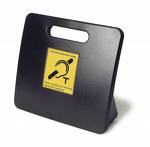This page covers:
Section C – Loop systems
What is a loop system?
C.a. For loop systems in the home: see TV and radio section and the doorbell
C.b. Loop systems in other public places and other people’s homes etc
C.c. Loop systems in the car
D Caption/subtitle glasses
Click on the links in the left hand column to see the other sections
What is a loop system?
An induction loop system consists of four main elements:
- Microphone
- Amplifier
- The loop (a wire installed around the room)
- The receiver (usually an individual’s hearing aid set to the ‘T’ position)

How do loop systems work?
An induction loop is a wire that goes around the listening area. A current from a loop amplifier powers the wire. The amplifier gets its signal from a microphone placed in front of the person speaking or speaker on the television. The resulting electric current in the loop produces a magnetic field. A deaf person can then pick up this magnetic field if they are sitting within the area of the loop and their hearing aid is switched to the ‘T’ setting.
The loop wire can go round the whole room or part of the room (as shown in the diagram above), the wire running around the skirting board or under carpets/rugs (this is a room loop),
or the loop wire can be around where the deaf person is sitting, (e.g. a loop pad on their chair),
or the loop wire can be around the person’s neck (a neck loop).
A neck loop works with a personal listener, which may have a built-in microphone and/or an external microphone which can given to a speaker or attached to the TV/radio speaker.
There are also loophooks which are the same as neckloops except that the loop is hooked over the ear and worn right next to the hearing aid.
________________________________________________________________________________
C.a For loop systems in the home:
see the TV and radio section which includes information about personal listeners and loops.
________________________________________________________________________________
C.b. Loop systems in other public places and other people’s homes, etc
 If a public place displays the ear symbol with a T in the corner it shows there should be a loop system available for people with compatible hearing aids.
If a public place displays the ear symbol with a T in the corner it shows there should be a loop system available for people with compatible hearing aids.
1. I ask for the loop to be switched on.
2. I ask where the best place is to sit (i.e. I find out which is the area “covered” by the loop).
3. If I go to a gathering where there is a loop system I test it before the session starts because it means that I can then go into the meeting feeling relaxed. (Editor’s note: It helps to remember that even a loop that has been tested can go wrong a short while later.)


Some public places have a portable loop which may look similar to the ones on the left.
Some people who have tried using portable loops have found them useful, others have found them to be not much use as they were not powerful enough for them, even when turned up to maximum volume
________________________________________________________________________________
C.c Loop systems in the car
It may also possible to obtain loops systems for some cars. This can help with either listening to passengers or listening to the car audio equipment (radio or CD, etc.) Some cars are not suitable as they can cause interference with the loop system.
Some personal listeners can also be used to pick up the loop signal in the car, but performance can vary from car to car. You also need to consider safety if using a personal listener in the car and make sure that in the event of an emergency stop, the listener will not fly about and cause injury. You could perhaps attach it to the dashboard with strong Velcro, or put it in your pocket.
________________________________________________________________________________
D Caption/Subtitle Glasses
There are now glasses which allow captions to be superimposed on the scene in front of you. The glasses are connected to a phone (Android only, at the time of writing).
The glasses allow you to read the conversation in real time.
For more information on this technology see the manufacturer’s website: https://xrai.glass